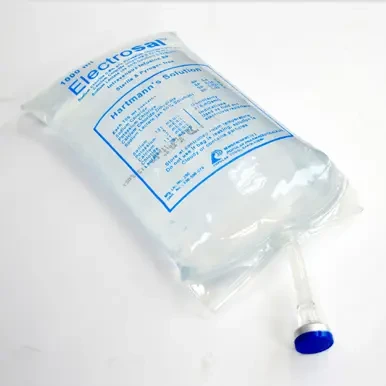500 ml bag:
৳ 71.30
1000 ml bag:
৳ 92.00
Indications
This is used to treat hypovolemia caused by surgery, hemorrhage and trauma. Excessive sweating, severe diarrhoea or vomiting, excess loss of fluid by nephritic kidneys, inadequate intake of fluid and electrolytes etc. that may lead to typical hypovolemic shock may be corrected with this solution. Severe plasma loss caused by intestinal obstruction, burns or other denuding conditions of the skin may be treated with this solution. It is mainly used as a fluid and electrolyte replenisher. It may be used as an alternative to Sodium Bicarbonate in the treatment of metabolic acidosis associated with dehydration and to alkalinized urine.
Composition
This is a sterile solution of Sodium Chloride, Potassium Chloride, Calcium Chloride and Sodium Lactate. Each 100ml of solution contains-
- Sodium Chloride BP 0.6 g
- Potassium Chloride BP0.04 g
- Calcium Chloride BP0.027 g
- Sodium Lactate 50% solution USP equivalent to 0.32 g of Sodium Lactate.
Dosage
The volume and rate of infusion will depend upon the requirements of the patients and the judgement of the physician. It usually varies with age, weight and clinical condition of the patient. The recommended flow rate is up to 100-drops/minute/70 kg body weight. In burn patients the dose of Hartmann's solution according to the Parkland formula: 4 ml/kg body weight% of Body surface area (BSA) burn (e.g. for a 30% BSA burn of a person having 60 kg body weight, 4 x 60 x 30 ml = 7200 ml of Hartmann's solution would be required in 24 hours). Half of this within 8 hr, the remainder over 16 hr.
Administration
- Check infusion set and infusion solution prior to use
- Pull moderately to tear off the protective cover of the Eurohead
- Hold lightly the Eurohead but not the bag
- Open the flow regulator fully and hold the giving set on the top white area, but not the membrane venting region
- Insert the spike of the administration set to the Eurohead and fit the connector of the administration set firmly to the needle
- Gradually allow the fluid to flow down to the needle tip and close
- Remove the protective cover of the needle
- Locate the veinpuncture site and clean the site with an antiseptic solution, and then insert the needle
- Securely tape the puncture site
- Securely tape the wings and tubing
- Start infusion while adjusting drip speed
Contraindications
Do not take this medicine and tell your doctor if: Hartmann's solution may be relatively contraindicated in patients with diabetes mellitus, as one of the isomers of lactate is gluconeogenic.
Side Effects
Hands, ankles and feet may become mildly swollen from fluid retention. Rarely, the lungs can also be affected, which may cause breathing difficulty. Other possible symptoms include nausea, vomiting, headache, dizziness, drowsiness, confusion, and inflammation or swelling of the veins around the site of the injection.
Pregnancy & Lactation
Pregnancy Category C. Animal reproduction studies have not been conducted with Lactated Ringer’s Irrigation. It is also not known whether it can cause fetal harm when administered to a pregnant woman or can affect reproduction capacity. It should be given to a pregnant woman only if clearly needed.
Precautions & Warnings
Electrosal should not be administered rapidly or for prolonged periods. Since the solution contains different electrolytes, it should be infused with caution in patients where electrolyte imbalance may cause detrimental effects; e.g. in pregnancy, renal impairment, heart failure, pulmonary congestion, etc. or to patients receiving potassium sparing diuretics. In Pregnancy: Pregnancy Category C. Infusion of fluid should be immediately discontinued if rigor arises for any reason during the process. Do not use if the solution is cloudy, contains particles, or after expiry date. Infusion of fluid should be immediately discontinued if rigor arises for any reason during the process. Do not use if the solution is cloudy, contains particles, or after expiry date.
Therapeutic Class
Haemodialysis solutions
Storage Conditions
Electrosal should be stored at controlled room temperature.


